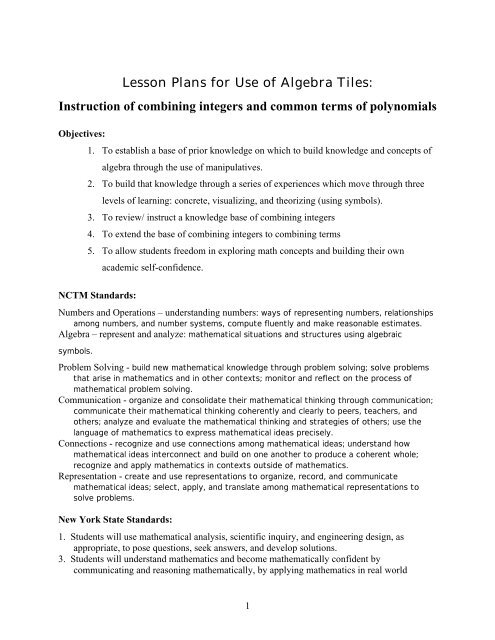Lesson Plans for Use of Algebra Tiles: Instruction
Lesson Plans for Use of Algebra Tiles: Instruction
Lesson Plans for Use of Algebra Tiles: Instruction
Create successful ePaper yourself
Turn your PDF publications into a flip-book with our unique Google optimized e-Paper software.
<strong>Lesson</strong> <strong>Plans</strong> <strong>for</strong> <strong>Use</strong> <strong>of</strong> <strong>Algebra</strong> <strong>Tiles</strong>:<br />
<strong>Instruction</strong> <strong>of</strong> combining integers and common terms <strong>of</strong> polynomials<br />
Objectives:<br />
1. To establish a base <strong>of</strong> prior knowledge on which to build knowledge and concepts <strong>of</strong><br />
algebra through the use <strong>of</strong> manipulatives.<br />
2. To build that knowledge through a series <strong>of</strong> experiences which move through three<br />
levels <strong>of</strong> learning: concrete, visualizing, and theorizing (using symbols).<br />
3. To review/ instruct a knowledge base <strong>of</strong> combining integers<br />
4. To extend the base <strong>of</strong> combining integers to combining terms<br />
5. To allow students freedom in exploring math concepts and building their own<br />
academic self-confidence.<br />
NCTM Standards:<br />
Numbers and Operations – understanding numbers: ways <strong>of</strong> representing numbers, relationships<br />
among numbers, and number systems, compute fluently and make reasonable estimates.<br />
<strong>Algebra</strong> – represent and analyze: mathematical situations and structures using algebraic<br />
symbols.<br />
Problem Solving - build new mathematical knowledge through problem solving; solve problems<br />
that arise in mathematics and in other contexts; monitor and reflect on the process <strong>of</strong><br />
mathematical problem solving.<br />
Communication - organize and consolidate their mathematical thinking through communication;<br />
communicate their mathematical thinking coherently and clearly to peers, teachers, and<br />
others; analyze and evaluate the mathematical thinking and strategies <strong>of</strong> others; use the<br />
language <strong>of</strong> mathematics to express mathematical ideas precisely.<br />
Connections - recognize and use connections among mathematical ideas; understand how<br />
mathematical ideas interconnect and build on one another to produce a coherent whole;<br />
recognize and apply mathematics in contexts outside <strong>of</strong> mathematics.<br />
Representation - create and use representations to organize, record, and communicate<br />
mathematical ideas; select, apply, and translate among mathematical representations to<br />
solve problems.<br />
New York State Standards:<br />
1. Students will use mathematical analysis, scientific inquiry, and engineering design, as<br />
appropriate, to pose questions, seek answers, and develop solutions.<br />
3. Students will understand mathematics and become mathematically confident by<br />
communicating and reasoning mathematically, by applying mathematics in real world<br />
1

















